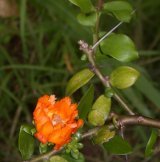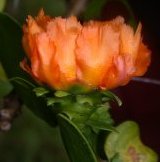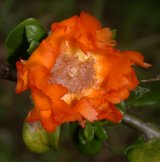 |
QUICK SEARCH
MO PROJECTS:
Africa
Asia/Pacific
Mesoamerica
North America
South America
General Taxonomy
Photo Essays
Training in Latin
America
MO RESEARCH:
Wm. L. Brown Center
Bryology
GIS
Graduate Studies
Research Experiences
for Undergraduates
Imaging Lab
Library
MBG Press
Publications
Climate Change
Catalog Fossil Plants
MO DATABASES:
W³MOST
Image Index
Rare Books
Angiosperm
Phylogeny
Res Botanica
All Databases
INFORMATION:
What's New?
People at MO
Visitor's Guide
Herbarium
Jobs & Fellowships
Symposium
Research Links
Site Map
Search
|
Draft Treatments | Guidelines | Checklist | Citing | Editors The Cutting EdgeVolume XVIII, Number 3, July 2011News and Notes | Leaps and Bounds | Germane Literature | Season's Pick | Annotate your copy
This sp. is most famously known in Costa Rica from a cultivated individual in a fence row along the road to Parque Nacional Palo Verde, near the intersection with the Panamerican Highway. These photos (thanks to Manual collaborator J. I. D. F. C. Morales, INB) were taken of that same plant in mid-June of this year. The sp., apparently nowhere common, ranges from Mexico to Costa Rica, where it is currently known from perhaps three other individuals, all in Prov. Guanacaste. Although the protologue of the synonymous P. nicoyana F. A. C. Weber implies that the sp. was a constituent of many bays on the hot and dry Pacific coast "(golfe de Nicoya, Guanacaste, Puntarenas, etc.)," the original material collected by Tonduz "autour des maison à Nicoya" seems likely to have been from a cultivated plant. Standley (in Flora of Costa Rica) likewise characterized it as "frequent in thickets of the Pacific coast," but if that was ever truly the case, the situation has changed dramatically. Recent Costa Rican records of P. lychnidiflora are vanishingly scarce. Palo Verde park functionary and former INBio parataxonomist Ulises Chavarría has collected it, presumably from the wild, at "Finca Carao," near Puerto Humo, along the Río Tempisque. Roberto Espinoza, resident botanist at Parque Nacional Santa Rosa, has informed us of the occurrence of an apparently non-cultivated plant at Playa Papaturro, on the south shore of the Bahía de Salinas. Morales reports that a wild individual is also known from Parque Nacional Barra Honda, but his understanding is that the sp. is very vulnerable to the constant fires that plague these forests during the dry season. To date, that is all we know of the distribution in Costa Rica of this rare and elegant sp. See also: Especies disponibles (INBio). |
||||||||
© 1995-2025 Missouri Botanical Garden, All Rights Reserved
4344 Shaw Blvd.
St. Louis, MO 63110
(314) 577-5100
Technical Support


